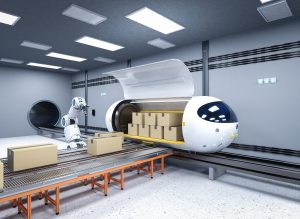 One of the many sectors affected by the rise of artificial intelligence and AI-powered tools is the transportation industry, particularly the rail industry.
One of the many sectors affected by the rise of artificial intelligence and AI-powered tools is the transportation industry, particularly the rail industry.
AI solutions are revitalizing a sector that was once known for its lack of innovation, changing train operation, management, and maintenance. Here are three ways artificial intelligence is changing railways.
AI and Autonomous Trains
The concept of a fully autonomous, driverless train is nothing new; the first mass-transit driverless rail network is Kobe’s Port Island Line, which opened in 1981.
However, it wasn’t until 2019 that the first fully automated, AI-driven locomotives were introduced: the AutoHaul system in Australia. This system operates and controls up to 50 locomotives, all 100% unmanned, delivering iron ore over a nearly 500-mile, 40 hour-long journey and representing a feat of artificial intelligence in engineering.
The railway industry uses the Grade of Automation (GoA) system to rank the level of automation and independence possessed by train control systems. The first three levels are:
- GoA 1 denotes a train employing a human train engineer as a driver but with a computer controlling speed.
- GoA 2 trains still have a human driver, but acceleration and braking are automated.
- GoA 3 trains drive autonomously, but human drivers remain on board to manage unexpected situations.
Although today’s rail systems feature various degrees of automation, most train systems worldwide have not advanced past GoA 1; in other words, they still overwhelmingly rely on human train engineers for operation.
AI-powered trains employ neural networks and machine learning to reach the highest grade of GoA 4. Trains at this level are fully autonomous and capable of driving safely without human crew members in all circumstances.
As of September 2021, only a small number of passenger train systems are GoA 4, including the Paris Metro Line 14 and the Sydney Metro. An AI-powered GoA 4 passenger train network offers numerous advantages:
- Reduce staffing costs (as train drivers are no longer necessary)
- Higher flexibility, allowing networks to carry more passengers at once and with higher service quality
- More consistent performance, ensuring trains run on-time more often
- Ecological benefits through the optimization of acceleration and braking times, reducing power consumption
One of the main challenges of rail network automation is adapting the existing infrastructure to account for it. According to European Union experts, rail automation requires gradual renovation and urban redevelopment, which may take several years.
For example, following tests in 2019, SNCF (France’s national railway operator) aims to introduce its first high-speed driverless trains by 2023.
AI and Predictive Maintenance
One of the most promising AI applications is the Internet of Things (IoT), connecting real-world objects to the Internet and big data processing centers to obtain information.
In the railway industry, IoT sensors can be used to monitor a train’s parts for wear and tear in real-time, using an AI’s computing power to predict maintenance schedules and prevent costly failures such as broken wheels.
Predictive maintenance is considered to be a more cost-effective approach than other railcar maintenance programs, such as fixed-schedule (fix at set intervals), reactive maintenance (fix when something fails), or no-maintenance (run-to-failure, replace as needed).
Unlike these traditional approaches to maintenance scheduling, AI-powered predictive maintenance adapts to each railcar and predicts when and how to conduct repairs before issues arise.
Predictive maintenance can also benefit railway tracks, using specialized vehicles to conduct automated rail inspections, gathering track data geometry, rail damage and wear rates, and other relevant information.
AI then processes this data and determines which railways need maintenance, which sections or areas suffered the most wear and tear, and what types of repairs should track maintenance engineers perform.
AI-powered predictive maintenance provides numerous benefits. It optimizes maintenance schedules, increases the availability of viable railcars and railways, and saves significant amounts of money on inspection costs and maintenance fees.
These economic advantages can optimize company and government budgets, helping them spend less on maintenance without sacrificing service quality.
AI-Powered Traveler Experience
Artificial intelligence and deep-learning systems can enhance more than rolling stock operation and maintenance; they can also power digital ticketing platforms, bringing passenger railways in line with the principles of the smart mobility industry.
In a 2020 press release, the Indian Railway Catering and Tourism Corporation (IRCTC) announced the modernization of their website and booking system, using artificial intelligence to enhance the passengers’ booking experience.
The systems powering the IRCTC website comprise deep-learning processes to predict the best combination of trains for the customer’s chosen itinerary, streamlining the booking process.
Booking systems no longer rely on paper tickets, employing e-tickets and mobile applications instead, similar to the systems used in the aviation industry. In addition, AI also uses customer data and trends to predict the price of a particular journey, informing customers in real-time before they select a trip.
Natural Language Processing (NLP) allows artificial intelligence to interpret a customer’s plain-language questions and queries (e.g., “Is my train running on time?” or “How is my commute doing?”), returning answers in real-time based on internal alerts and other status reports.
Start Your AI Engineering Career With OSPE
The Ontario Society of Professional Engineers is an organization whose mission is to bring together engineering students and professionals, giving a voice to the engineering community.
If you’re looking to become an AI engineer and work on real-world solutions for today’s challenges, becoming an OSPE member provides you with learning and networking opportunities. From mentorship programs to job searching workshops, the OSPE is committed to supporting you every step of the way, even after you obtain certifications or find employment.


